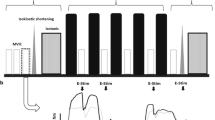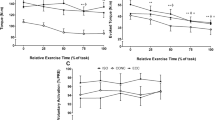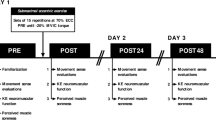Abstract
Using the KinCom 500H isokinetic dynamometer the first part of this study measured the characteristics of the force velocity relationship curve for the human knee extensors between −1.57 (eccentric) and 3.67 (concentric) rads · s−1 (−90 and 210° s1) for both legs in 4 subjects. A significant increase in force generation was seen in eccentric activity at 0.52 rads · s−1 (30° s−1) but not at 1.57 rads · s−1 (90° s−1) compared to maximum voluntary isometric force (P < 0.005). This increase was, however, lower than would be expected from the classical force-velocity relationship. The second part of the study examined whether restricting the range of movement was able to further increase the eccentric forces. In a further 6 subjects, the eccentric contractions were repeated during either an 80° (15–95° flexion) and a 50° (45–95° flexion) range of movement. Significant increases in force were seen over the shorter range of movement at 0.52 rads · s−1 (30° s−1) (P = 0.006) and 1.57 rads · s−1 (90° s−1) (P < 0.001).
Similar content being viewed by others
Author information
Authors and Affiliations
Additional information
Accepted: 14 May 1999
Rights and permissions
About this article
Cite this article
Holder-Powell, H., Rutherford, O. Reduction in range of movement can increase maximum voluntary eccentric forces for the human knee extensor muscles. Eur J Appl Physiol 80, 502–504 (1999). https://doi.org/10.1007/s004210050624
Issue Date:
DOI: https://doi.org/10.1007/s004210050624




